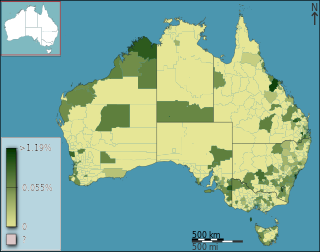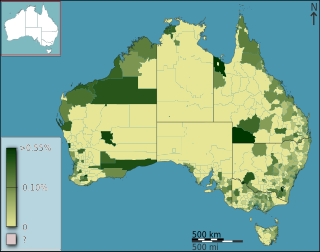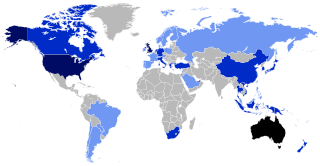| Total population | |
|---|---|
| Peruvian 8,440 (by birth, 2011 Census ) [1] 8,630 (by ancestry, 2011 Census ) [1] | |
| Regions with significant populations | |
| New South Wales | 5,714 |
| Victoria | 1,416 |
| Queensland | 1,128 |
| Western Australia | 685 |
| Languages | |
| English (Australian English), Spanish (Peruvian Spanish) | |
| Religion | |
| Christianity (Predominantly Roman Catholicism) | |
| Related ethnic groups | |
| Hispanic and Latin American Australians | |
Peruvian Australians refers to Australian citizens of Peruvian descent or Peru-born person who reside in Australia.
Most Peruvian Australians reside in the state of New South Wales. [1] [2]
According to a census carried in 2016 by Department of Home Affairs, 9,556 Australians were born in Peru, while 11,139 claimed Peruvian ancestry. [2]
The 2016 distribution by State and Territory showed New South Wales had the largest number with 5,714 followed by Victoria (1,416), Queensland (1,128) and Western Australia (685). [2]
The first official record of Peruvians in Australia is the census conducted in 1901 when 28 Peruvians were recorded. [3]
Immigration from Peru remained small until the late 1960s when the numbers started to increase slowly.
Arrivals have continued to rise in the 21st century, with 24.6% of the Peru-born population arriving in Australia between 2007 and 2011. [3]

Thai Americans are Americans of Thai ancestry. The Thai American population is racially and ethnically diverse, consisting of many Thais who identify as mixed race and as Thai Chinese.

Greek Australians are Australians of Greek ancestry. Greek Australians are one of the largest groups within the global Greek diaspora. As per the 2021 Australian census, 424,750 people stated that they had Greek ancestry, comprising 1.7% of the Australian population. At the 2021 census, 92,314 Australian residents were born in Greece.

Peruvian Americans are Americans of Peruvian descent.

Filipino Australians are Australians of Filipino ancestry. Filipino Australians are one of the largest groups within the global Filipino diaspora. At the 2021 census, 408,836 people stated that they had Filipino ancestry, representing 1.6% of the Australian population. In 2021, the Australian Bureau of Statistics estimated that there were 310,620 Australian residents born in the Philippines.
Sudanese Australians are people of Sudanese origin or descent living in Australia. The largest population of Sudanese Australians reside in Victoria (6,085).

Barooga is a border town in the Murray region of New South Wales, Australia, located in the Berrigan Shire local government area. It is situated just north of the Murray River which forms the border with Victoria. Barooga's population at the 2021 census was 1,888.

Korean Australians are Australian citizens who trace their Korean ancestry and identify themselves as an immigrant to or a descendant born in Australia.

Thai Australians refers to Australians who trace their ancestry to Thailand or Thais who trace their ancestry to Australia. The Australian census recorded 45,635 Australians with Thai ancestry in the 2011 census.

Australians, colloquially known as Aussies, are the citizens, nationals and individuals associated with the country of Australia. This connection may be residential, legal, historical or ethno-cultural. For most Australians, several of these connections exist and are collectively the source of their being Australian. Australian law does not provide for a racial or ethnic component of nationality, instead relying on citizenship as a legal status.
Indonesian Australians are Australian citizens and residents of Indonesian origin. 48,836 Australian residents declared Indonesian ancestry on the 2011 Australian Census, while 63,160 stated they were born in Indonesia.

Bangladeshi Australians refers to Australian citizens or residents who have full or partial Bangladeshi heritage or people who emigrated from Bangladesh and reside in Australia. There are around 51,491 people born in Bangladesh living in Australia, according to the census in 2021. Additionally, there is a significant number of Bangladeshi descent Australians, but their numbers are uncertain. The largest Bangladeshi communities are mainly present in the states of New South Wales and Victoria, with large concentrations in the cities of Sydney and Melbourne.
Estonian Australians refers to Australian citizens of Estonian descent or Estonia-born persons who reside in Australia. According to the 2021 Census, there were 11,598 people of Estonian descent in Australia and 2,665 Estonia-born people residing in the country at the moment of the census, having a increase of21 per cent compared to the 2016 Census. The largest Estonia-born community in Australia is in the state of New South Wales, with 4,265 people.

Singaporean Australians are Australians of Singaporean descent. As Singapore is a multi-racial country, a Singaporean Australian could either be of Chinese, Malay or Indian descent, the main races of Singapore. According to the 2006 Australian census, 39,969 Australians were born in Singapore while 4,626 claimed Singaporean ancestry, either alone or with another ancestry.
Israeli Australians refers to Australian citizens or permanent residents who are fully or partially of Israeli descent. The population colloquially refer to themselves as Ausraelis.

New Zealand Australians refers to Australian citizens whose origins are in New Zealand, as well as New Zealand migrants and expatriates based in Australia. Migration from New Zealand to Australia is a common phenomenon, given Australia's proximity to New Zealand, its larger economy, free movement agreement and cultural links between the two countries.
Nigerian Australians are Australian citizens and residents of Nigerian origin or descent. The Nigerian-born form one of the fastest-growing migrant groups in Australia.
South Sudanese Australians are people of South Sudanese ancestry or birth who live in Australia.
Lithuanian Australians refers to Australian residents of Lithuanian national background or descent. According to the 2021 Census, there were 19,430 people of Lithuanian descent in Australia and 2,582 Lithuania-born people residing in the country at the moment of the census. As of 2016, the largest Lithuanian Australian community resides in the state of New South Wales, with 1022 Lithuania-born people, especially located in Sydney.
Mauritian Australians are Australians of Mauritian descent, or who were born in Mauritius.
Gabriela Ruffels is an Australian American former tennis player and current professional golfer. Starting at the age of eight, Ruffels started playing tennis and won twenty one International Tennis Federation doubles events in Europe. She also was the number one ranking Australian junior when she was twelve. After switching from tennis to golf in 2015, Ruffels primarily competed in Australia from 2016 to 2017. In 2018, Ruffels joined the USC Trojans women's golf team at the University of Southern California. With USC, Ruffels appeared at the NCAA Division I Women's Golf Championships from 2018 to 2019 in both the individual and team events.